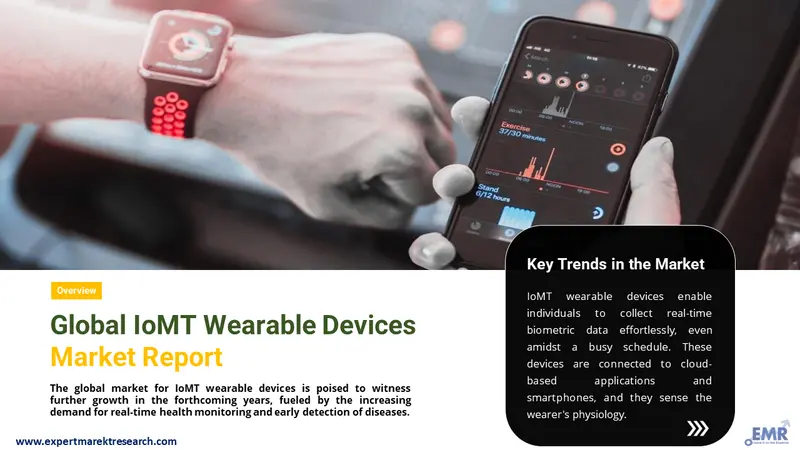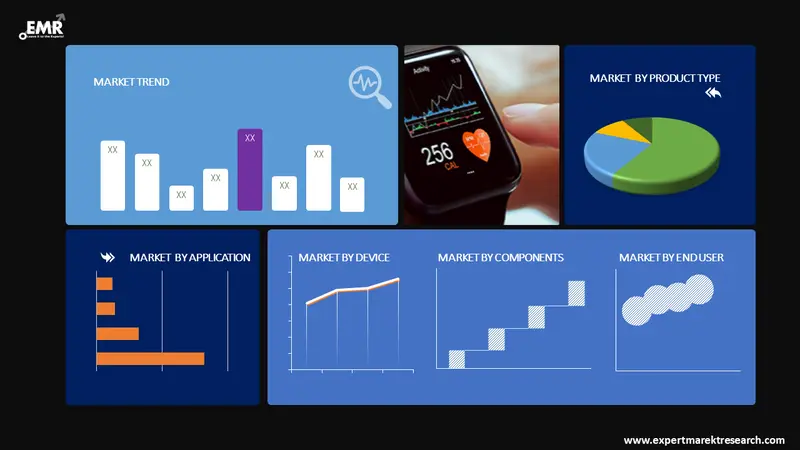
Consumer Insights
Uncover trends and behaviors shaping consumer choices today
Procurement Insights
Optimize your sourcing strategy with key market data
Industry Stats
Stay ahead with the latest trends and market analysis.
The global IoMT wearable devices market was valued at USD 42.96 Billion in 2025, driven by the rising demand for real-time health monitoring across the globe. The market is expected to grow at a CAGR of 23.00% during the forecast period of 2026-2035 to attain a value of about USD 340.50 Billion by 2035.
Base Year
Historical Period
Forecast Period
The growing demand for remote patient monitoring (RPM) as a result of an increasing aging population and rising chronic disease burden is a primary driver of the market.
One of the major market trends is the increased focus on developing multi-functional wearable devices integrated with a wide range of advanced features, which can appeal to both fitness enthusiasts and patients with chronic conditions.
The rising awareness about personal health and wellness and the growth in telemedicine platforms are impacting the market value in the forecast period.
Compound Annual Growth Rate
23%
Value in USD Billion
2026-2035
*this image is indicative*
IoMT (Internet of Medical Things) wearable devices form a subset of IoT (Internet of Things) that are designed to improve patient outcomes. These wearable medical devices help in providing real-time health monitoring, efficient management of chronic conditions, and personalized treatment plans. The growing demand for continuous monitoring and the increasing prevalence of chronic diseases are driving the adoption of IoMT wearable devices. The rising advancements in wearable technology including the miniaturization of sensors, improvements in battery life, and wireless connectivity, are also contributing to the market growth. The growing investment in digital health technologies, heightened awareness about personal health and wellness, and rising partnerships and collaborations between technology firms are some of the factors shaping the market dynamics.

Read more about this report - REQUEST FREE SAMPLE COPY IN PDF
Rise in Strategic Partnerships are Impacting Market Growth
In March 2024, Premier Wireless Business Technology Solutions, Inc., announced a partnership with a leading wearable remote monitoring company, Somatix, to advance the growth of digital healthcare through remote monitoring and communication. Premier Wireless' CPR3 platform helps in connecting patients with vital healthcare resources. On the other hand, Somatix offers a wrist-based wearable smart band that works on its novel gesture detection technology to deliver alerts, predictive analytics, insights, and notifications to the patient’s care teams and partners. This collaboration aims to leverage the most advanced technologies to deliver the best solutions in the home healthcare and telehealth space. Such strategic partnerships are expected to bolster the market growth.
The market is witnessing several trends and developments to improve the current global scenario. Some of the notable trends are as follows:

Read more about this report - REQUEST FREE SAMPLE COPY IN PDF
The EMR’s report titled “IoMT Wearable Devices Market Report and Forecast 2026-2035" offers a detailed analysis of the market based on the following segments:
Market Breakup by Product Type
Market Breakup by Application
Market Breakup by End Use
Market Breakup by Sales Channel
Market Breakup by Region
Market Segmentation Based on Product Type is Anticipated to Witness Substantial Growth
Based on the product type, the market is segmented into fitness wearables, clinical grade wearables, and remote patient monitoring devices, among others. Fitness wearables hold a major share of the product type segment owing to the growing interest in health and wellness among the general population. The rising integration of various health metrics in these devices such as step counting, heart rate monitoring, and sleep tracking, is increasing their market demand. Fitness wearables are typically more affordable than clinical-grade devices and thus are widely adopted by a larger consumer base. Moreover, the increasing innovations in wearable technology, including improved sensors and longer battery life, are poised to support market growth in the forecast period.
North America is the leading market for IoMT wearable devices due to the high adoption of advanced technologies and substantial investment in the healthcare IT sector. In North America, particularly the United States, the market is witnessing a growing demand for remote patient monitoring (RPM) devices as a result of an increasingly aging population and rising healthcare needs. Moreover, the presence of key technology and healthcare companies in the region also reinforces the market growth in North America.
The key features of the market report comprise patent analysis, grants analysis, funding and investment analysis, and strategic initiatives by the leading key players. The major companies in the market are as follows:
American technology company Apple Inc., headquartered in California, in Silicon Valley, is recognized globally for its consumer electronics, software, and other services. The company's Apple Watch series has a significant consumer demand and is integrated with various health features such as ECG monitoring and blood oxygen level measurement.
Best Buy Health is a prominent player in the market and specializes in remote monitoring solutions for aging adults. The company is focused on expanding its healthcare services by leveraging strategic partnerships with other health technology firms.
BioIntellisense Inc. is one of the leading players in the market known for developing clinical intelligence platforms that are designed for continuous health monitoring, algorithmic insights, and predictive analytics.
BioTelemetry, acquired by Philips in 2021, specializes in the development of wearable cardiac devices that monitor heart conditions in real-time. The company boasts a strong portfolio of cardiac monitoring devices, including mobile cardiac telemetry (MCT) devices, Holter monitors, and event monitors.
*Please note that this is only a partial list; the complete list of key players is available in the full report. Additionally, the list of key players can be customized to better suit your needs.*
Other key players in the market include Gabit, Google LLC, Masimo, Social Mobile, and VivaLNK Inc.




*While we strive to always give you current and accurate information, the numbers depicted on the website are indicative and may differ from the actual numbers in the main report. At Expert Market Research, we aim to bring you the latest insights and trends in the market. Using our analyses and forecasts, stakeholders can understand the market dynamics, navigate challenges, and capitalize on opportunities to make data-driven strategic decisions.*
Get in touch with us for a customized solution tailored to your unique requirements and save upto 35%!
Explore our key highlights of the report and gain a concise overview of key findings, trends, and actionable insights that will empower your strategic decisions.
| REPORT FEATURES | DETAILS |
| Base Year | 2025 |
| Historical Period | 2019-2025 |
| Forecast Period | 2026-2035 |
| Scope of the Report |
Historical and Forecast Trends, Industry Drivers and Constraints, Historical and Forecast Market Analysis by Segment:
|
| Breakup by Product Type |
|
| Breakup by Application |
|
| Breakup by End Use |
|
| Breakup by Sales Channel |
|
| Breakup by Region |
|
| Market Dynamics |
|
| Supplier Landscape |
|
| Companies Covered |
|
Datasheet
One User
USD 3,299
USD 2,969
tax inclusive*
Single User License
One User
USD 5,499
USD 4,949
tax inclusive*
Five User License
Five User
USD 6,999
USD 5,949
tax inclusive*
Corporate License
Unlimited Users
USD 8,199
USD 6,969
tax inclusive*
*Please note that the prices mentioned below are starting prices for each bundle type. Kindly contact our team for further details.*
Flash Bundle
Small Business Bundle
Growth Bundle
Enterprise Bundle
*Please note that the prices mentioned below are starting prices for each bundle type. Kindly contact our team for further details.*
Flash Bundle
Number of Reports: 3
20%
tax inclusive*
Small Business Bundle
Number of Reports: 5
25%
tax inclusive*
Growth Bundle
Number of Reports: 8
30%
tax inclusive*
Enterprise Bundle
Number of Reports: 10
35%
tax inclusive*
How To Order

Select License Type
Choose the right license for your needs and access rights.

Click on ‘Buy Now’
Add the report to your cart with one click and proceed to register.

Select Mode of Payment
Choose a payment option for a secure checkout. You will be redirected accordingly.
Gain insights to stay ahead and seize opportunities.

Get insights & trends for a competitive edge.

Track prices with detailed trend reports.

Analyse trade data for supply chain insights.

Leverage cost reports for smart savings

Enhance supply chain with partnerships.

Connect For More Information
Our expert team of analysts will offer full support and resolve any queries regarding the report, before and after the purchase.
Our expert team of analysts will offer full support and resolve any queries regarding the report, before and after the purchase.
We employ meticulous research methods, blending advanced analytics and expert insights to deliver accurate, actionable industry intelligence, staying ahead of competitors.
Our skilled analysts offer unparalleled competitive advantage with detailed insights on current and emerging markets, ensuring your strategic edge.
We offer an in-depth yet simplified presentation of industry insights and analysis to meet your specific requirements effectively.
Share